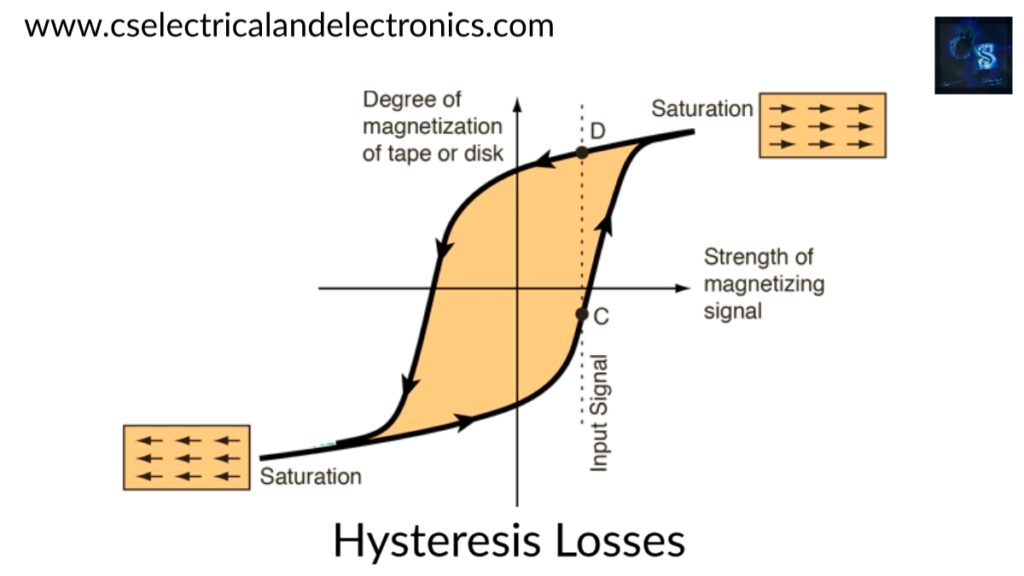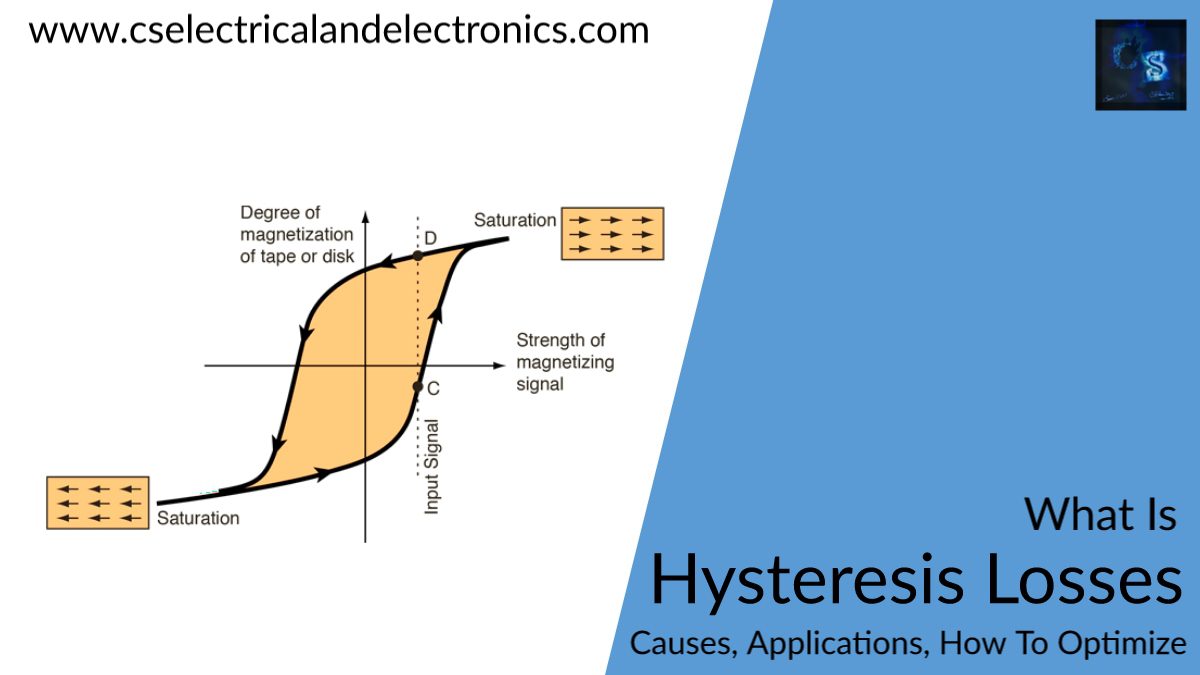What Is Hysteresis Losses, Causes, How To Optimize Hysteresis Losses
Hello guys, welcome back to my blog. In this article, I will discuss what is hysteresis losses, cause of hysteresis losses, working, applications, factors affected it, and how to optimize the hysteresis losses.
If you have any electrical, electronics, and computer science doubts, then ask questions. You can also catch me on Instagram – CS Electrical & Electronics And Chetan Shidling.
Also, read:
- What Is Fault Current Limiters In Power System, Advantages, Applications
- What Is SoC, SoH, SoP, SoT, SoS In Battery, State Of Charge, Health
- Types Of Losses In PV System, Photovoltaic Losses, PV Losses
What Is Hysteresis Losses
When current supplies are in the forward and reverse directions, hysteresis loss might occur due to the magnetization and demagnetization of the core. The molecules of the magnetic material are aligned in one direction when the magnetization force is applied within the magnetic material. This force may be reversed; the internal reflection of molecular magnets opposes the reversal of magnetism, resulting in Magnetic Hysteresis. By using a portion of the magnetizing force, the internal reflection may be overcome.
Heat is produced by the magnetizing force working against the internal friction of the magnet’s molecules. Hysteresis Loss is the amount of energy wasted as heat as a result of hysteresis.
When a magnetization force is given to a magnetic substance, the molecules of the magnetic material align in one direction. When the magnetic force is reversed in the opposite direction, the molecular magnets’ internal friction resists the reversal of magnetism, resulting in Magnetic Hysteresis.
A portion of the magnetizing force is utilized to wipe away or overcome this internal friction (also known as residual magnetism). The work done by the magnetizing force creates heat, resulting in energy waste in the form of heat, which is referred to as hysteresis loss.
Let us use the example of electrical machines to better grasp this notion, as hysteresis loss happens mostly when there is a reversal of magnetism, such as in the magnetic sections of electrical machines.

As a result of this loss, the machine’s temperature rises, wasting energy in the form of heat, which is an undesirable process for machines.
As an outcome, these electrical machinery components are made from a suitable magnetic material with a low hysteresis loss and a narrow hysteresis loop.
The hysteresis curve depicts the main connection between ‘H’ (magnetizing force) and ‘B’ (flux density). The needed energy to accomplish a complete cycle of magnetizing and de-magnetizing is shown in the hysteresis loop region. The loop area mostly indicates the energy wasted throughout the process.
Affected Factors:
Several elements have an influence on hysteresis loss, with a few of the causes impacting hysteresis loss being listed below:
- The loss is primarily due to the magnetic substance’s performance.
- Because different ‘B’ values have different saturation points, the hysteresis loop is influenced.
- The loop’s size and form are determined by the specimen’s starting point.
- When a magnetic material is difficult to magnetize, it produces a big hysteresis loop, which is undesirable.
- The loop will be narrow for the suitable magnetic material.
How to Optimize Hysteresis Losses?
By employing material with a smaller hysteresis loop, hysteresis losses can be decreased. As a result, high-grade or silica steel may be utilized to construct the core of a transformer since the hysteresis loop is exceedingly small.
To mitigate this loss, a specific core material that approaches zero/non-zero flux density after the current flow is removed can be employed.
Increase the number of laminations supplied through fewer gaps between plates to reduce these losses. By selecting a softcore with less hysteresis, hysteresis loss may be reduced. Silicon steel is the greatest illustration of this. The flux density, laminated core, and frequency all play a role in these losses.
Applications:
The hysteresis loop is important because it offers information on retentivity, coercivity, permeability, susceptibility, and energy loss for each ferromagnetic material throughout one cycle of magnetization. As a result, understanding the hysteresis loop will aid us in picking appropriate and compatible materials for a certain application.
The applications of hysteresis losses include of following:
- Signal filtering is used in control systems.
- This notion is used in the field of aerodynamics when the angle of attack of the wing is reduced following a stall.
- In ferromagnets, it’s used to keep their memory.
- Observing the compliance of the lung at the moment of inspiration is also indicated in respiratory physiology.
- It’s popular in labor economics, but it’s also useful in neurology, immunology, voice and speech, and genetics.
To summarize, hysteresis losses are caused by the magnetic agitation of the iron molecules and their resistance to movement. Each molecule in a magnetic substance has a north and south pole, according to one hypothesis of magnetism. The fields cancel each other out when the molecules are organized in a random pattern with north and south poles pointing in every direction, and the material is not magnetized.
The molecules of the core will align their poles based on the “left-hand rule” of electromagnetism when a loop of wire with a current running through it is put around the core of the transformer. Because AC is employed, the direction of current in the coil is always changing, and the magnetic field in the coil is also continually changing. As a result, the molecules in the core are always traveling in the right direction. They collide with one other as they travel, producing friction and heat.
This was about “What Is Hysteresis Losses“. I hope this article may help you all a lot. Thank you for reading.
Also, read:
- 10 Tips To Maintain Battery For Long Life, Battery Maintainance
- 10 Tips To Save Electricity Bills, Save Money By Saving Electricity
- 100 (AI) Artificial Intelligence Applications In The Automotive Industry
- 100 + Electrical Engineering Projects For Students, Engineers
- 1000+ Automotive Interview Questions With Answers
- 1000+ Control System Quiz, Top MCQ On Control System
- 1000+ Electrical Machines Quiz, Top MCQs On Electrical Machines
- 1000+ MATLAB Simulink Projects For MTech, Engineering Students

